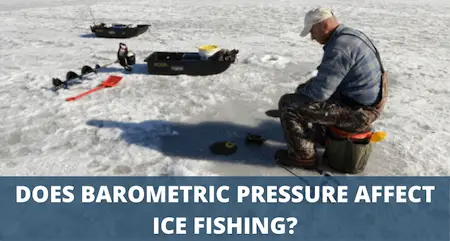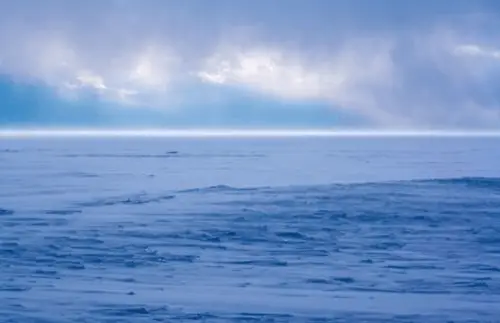How Does Weather Affect Ice Fishing, And What Barometric Pressure is Best?
UPDATED 18 MAY 2023
by Robert Ceran
Are you wondering if fish underneath a thick layer of ice are sensitive to barometric pressure? And if yes, what barometric pressure is best for ice fishing?
Here’s the quick answer:
Since barometric pressure changes are transmitted through ice and into water, fish respond to these changes even underneath a layer of ice.
In general, stable low to medium pressure conditions result in fair ice fishing success, while very low pressure conditions result in poor fishing success.

The best ice fishing conditions arise when barometric pressure rapidly drops just before a storm front arrives.
Can fish sense barometric pressure changes through ice?
Atmospheric pressure refers to the weight of the atmosphere, which pushes down on the surface of the earth. It is highest at sea level, and decreases the higher you move into the atmosphere, since there is less air pushing down from above.
Air pressure is measured with a barometer, which is why it’s also called barometric pressure, and it is usually recorded in inches of mercury.
Similar to air, bodies of water have hydrostatic pressure, although their pressure is greater, due to the higher density of water.
The important thing you need to know about this is that the atmosphere pushes down on the water, and a change in atmospheric pressure is transmitted into the water underneath it, leading to a change in hydrostatic pressure of the water.
But what about barometric pressure and ice fishing? You might be asking yourself: won’t a barrier of ice stop atmospheric pressure changes from affecting water pressure underneath it?
Well, since the ice itself is being pushed down by atmospheric pressure, air pressure changes are still transmitted through a layer of ice, and hence do affect water pressure underneath it.
Now, fish are extremely sensitive to hydrostatic pressure, which they sense through their air filled swim bladder and lateral line organ.
Because of this, they sense minute changes in pressure, and these changes can have big effects on their behavior.
And since atmospheric pressure changes are transmitted through ice, fish also respond to them underneath the ice.
What is the best barometric pressure for ice fishing?
Since fish can sense barometric pressure changes underneath the ice, the next question is: what pressure conditions are best for ice fishing?
Below is a chart comparing fish feeding behavior during different air pressure conditions for ice fishing:
| Air Pressure | Ice Fishing Activity To Expect |
|---|---|
| High pressure (over 30.50), stable conditions | Medium feeding activity, feeding correlates with other factors |
| Medium pressure (29.70 to 30.50), stable conditions | Medium to fair feeding activity, feeding correlates with other factors |
| Low pressure (29.00 to 29.70), stable conditions | Medium to fair feeding activity, feeding correlates with other factors |
| Very low pressure (under 29.00), stable conditions | Low feeding activity, hard to catch fish |
| Pressure decreasing rapidly (low pressure area approaching) | *VERY HIGH FEEDING ACTIVITY - best barometric pressure for ice fishing* |
| Pressure increasing rapidly (low pressure area departing) | Low feeding activity, hard to catch fish |
Table 1: Barometric pressure ice fishing chart
In general, if the barometric pressure is stable, fish feeding behavior is more correlated with other factors, such as time of day, light levels, activity of prey, and so on, without being tied to air pressure.
In other words, the absolute air pressure doesn’t seem to matter so much to fish behavior as long as it is stable.
This makes sense intuitively, since stable air pressure allows fish to acclimatize to it, and so won’t trigger changes in behavior.
The only exception to this seems to be very low pressure weather, which correlates with low levels of fish fish feeding activity even if it persists over several days.
Barometric pressure seems to have the largest impact on fish feeding behavior when it’s in the process of changing. Rapid change from high to low (resulting in increased activity), or from low to high (resulting in decreased activity) has the largest effect on fish.
Another factor to consider is that different weather conditions come with different sunlight levels. In my experience many fish, including panfish and perch, prefer dimly lit conditions during the winter months, and shy away from bright light.
Some anglers report lower hardwater fishing success rates during stable periods of high pressure weather, but this may be due to the fact that fish are more active during the night at a time when the days are very bright.
In other words, you can catch plenty of fish during the night even during stable high pressure periods.
The best weather for ice fishing
As you can see from the chart above, the very best time to go ice fishing is when a low pressure area is moving in.
Countless ice anglers have reported a “feeding frenzy” during conditions like this. This seems to hold true across a wide range of species, ranging from crappies and bluegills to trout and walleyes.

Personally, my best ice fishing experiences have always happened when the barometer was falling due to a winter storm rolling in.
During a stable high pressure system I can still catch fish, but it’s hard work finding the right spots and the right depth, and most activity is around dawn and dusk.
But when a snowstorm is coming, my buddies and I have caught fish at any time of the day, and it seems they’ll snap up almost any bait as fast as we can present it to them.
Interestingly, the increased feeding behavior of fish during these conditions stops abruptly when the bad weather front has fully settled in, so it’s essential to take advantage of the 12-24 hours just before that.
It seems it’s not the actual low pressure weather itself that triggers increased feeding behavior, but rather the change in pressure as it goes down. Once the low air pressure becomes stable, the fish stop feeding.
The worst weather for ice fishing
The worst time to go ice fishing is either during very low pressure conditions that are stable, or when the pressure is increasing rapidly after a bad weather front is on the way out. It seems that the fish need time to adjust to high pressure weather once again before they return to normal feeding behavior.
In other words, don’t bother going out on the ice until 2-3 days after a bad weather front has moved out, giving the fish some time to re-adjust to fair weather.
How to adjust to poor ice fishing conditions
If you find that the weather isn’t ideal for fishing success, you can often still find a way to get some fish in your bucket. It’ll just require being more strategic in how you fish and where you fish, and you’ll probably need to test different methods to entice fish to bite.
During these conditions, it’s essential to have a flasher or fish finder. Very often, fish move to a different location, or different depth when weather conditions change, and you need to know where to find them after they move.
Another way to follow the movement of fish during changing conditions is to use an ice fishing camera, such as Aqua-Vu or Marcum.
You can also use your flasher to observe the reaction of fish to your lure presentation. If you can see them on your screen, but they don’t show any interest in your lure, it’s time to change things up and try something new.
Very often, when fish stop feeding after a change in weather, that’s the moment to try some finesse techniques, which can get fish to strike even when they’re not interested in feeding.
Final remarks
This concludes our discussion on barometric pressure and ice fishing.
The best way to take advantage of this information is to keep a constant eye on the weather forecast for the next few days.
If you’re currently in a stable high pressure situation (fair weather), and the weather forecast announces a bad weather front coming in, that’s the moment to get ready to hit the ice and fish with everything you’ve got.
But please keep in mind that you don’t want to be caught out on the lake in the middle of a snowstorm, so be prepared to get out of there in time.
Hungry to learn more? Check out our beginners guide to ice fishing.
